#130: The History of Charleston Harbor, The "Real" Rhett Butler, and Carolina Gold Rice
For South Carolina history lovers far and wide! Published weekly on Monday mornings. Enjoy weekly SC history articles, interviews w/ experts, book recommendations, and upcoming SC historical events.
Dear readers,
Welcome to SC History Newsletter #130!
I can’t believe we have had not one, but two snow days in South Carolina (so far) this year! I hope everyone stayed safe in the recent weather, but also got to enjoy the fun and beauty of the snow as well. I know we did :)
I’d like to welcome the following new subscribers!
tracienyc
bnnemory94
nlew
johnsontrina10
ebmurphy4077
sled253
stacyemory
crygh
joshbazzlesubstack
betsy.hannan
smoakandrives
kowens
Deana.Broach
dshelley
Thank you so much, as always for supporting the newsletter — it truly means so much :)
And now, let’s learn some South Carolina history!
Yours truly,
Kate
(Writing from Greenville, SC)
➳ Housekeeping for new subscribers!
New friends! If you are new to the newsletter, please note that there are over 100 previous SC History newsletters on topics ranging from the founding of Charleston, sunken Confederate submarines, railroad tunnels filled with blue cheese, and so much more! I encourage you to take a look at our archive here. And here are a few top posts to start you off:
#107: Surviving Hurricane Hugo, a Textile Tour, and the Combahee River Raid
#122: General Nathanael Greene, Revolutionary War "Lunch & Learn," and The Demon of Unrest
Send me your comments or topic ideas: I love it when subscribers write to me! Have a SC History topic or question you’d like for me to write about? Have additional ideas or feedback for me? Just reply to this email and let me know!
Join us on social: Please join us & keep the conversation going by becoming a member of our SC History Newsletter Facebook Community here! I can’t wait to meet you. :)
If your email “cuts off”: In your email app or website, if my emails “cut off” for you, please click the title of the email and it will take you to the full post on the Substack. I don’t want you to miss any content!
As of today 1/27/25, we are at 858 subscribers. Help us get to 1,000 subscribers! Share the SC History Newsletter with a fellow history lover! :)
➳ Featured SC History Events
Please note our featured SC History Event below, and as a perk for paid subscribers, click here or the button below to visit my full SC History Events Calendar that organizes all the upcoming SC history events I have discovered.
Please let me know if you’d like to add an event to the calendar! Reply to this email to send me your events.
Event Highlight of the Week:
Tuesday, January 28th at 7:00 pm | “South Carolina General Thomas Sumter - Lecture by Durant Ashmore” | Laurens County Museum | Laurens, SC | $5 suggested donation | Website
“Durant Ashmore will speak about the life, times, and military achievements of South Carolina General Thomas Sumter. This lecture is at the Laurens County Museum at 116 South Public Square, Laurens, and is open to the public.
Museum members and youth are free to attend. There is a suggested donation of $5 for non-members for museum support.
The Laurens County Museum exhibit hall is free to visit and open to the public Tuesday through Saturday from 10:00 am until 3:00 pm. The museum is a non-profit membership association.”
➳ Other SC History Recommendations
Carolina Gold Rice
Note from Kate: I wrote SC History Newsletter #76 about South Carolina Gold Rice (read here) and it inspired me to purchase and cook some of this legendary, historic rice for my own family. It was so delicious and had a unique, nutty flavor from regular rice! I also loved this quote from my research:
Professor David Shields is the Carolina Distinguished Professor of the English Language and Literature Department at University of South Carolina and the chair of the Carolina Gold Rice Foundation. He is a devotee and ambassador for the legendary Carolina Gold Rice. He describes his love for the rice in a 2023 article from SeriousEats.com:
"It just had this really satisfying mouthfeel…The textural thing people told me about was there; so was the hazelnut thing. All I could think was, 'Boy, this tastes just like I want rice to taste: wholesome. Satisfying.' Part of my boyhood was spent in Japan eating very good rice. I had congee as my morning grain, instead of oatmeal or Cream of Wheat. So I have very strong associations with domestic harmony and tranquility and a bowl of rice porridge. When I tasted Carolina Gold, I had that same sense of satisfaction."
Have you eaten Carolina Gold Rice before? Leave a comment below!
➳ SC History Topic of the Week:
The History of the Charleston Harbor
Charleston Harbor has been the “economic heart”1 of South Carolina since the founding of the colony.
First, let’s look at a visual so we can get our geography straight. The city of Charleston sits at the end of a peninsula where the Ashley and the Cooper rivers meet. The waters flow into Charleston Harbor, and from there, flow into the Atlantic Ocean (lower right).
When the first English settlers arrived in the harbor in 1670, they established “Charles Towne” off the Ashley River. The settlers remained at the original settlement until 1680, when they packed up and moved further into the peninsula to have better access to the harbor.
Thereafter, the settlers created a fortified city and used the harbor for trade. As rice plantations developed along the coast, the harbor became a prosperous center for commerce and trade.
In fact, Royal Governor John Glen noted exports of 264,788 barrels of rice (or 44,081 tons) of exported rice, which rose to 499,525 barrels of rice (or 99,905 tons) by 1739.2
The harbor and city’s rising prosperity brought new dangers, as the harbor became “a tantalizing target for foreign enemies and pirates.”3
In 1706, a French and Spanish force attacked Charles Towne, but was defeated by the local militia.
In 1718, the famous pirate Blackbeard attacked the young city “in order to receive medicine for his pirates.”4
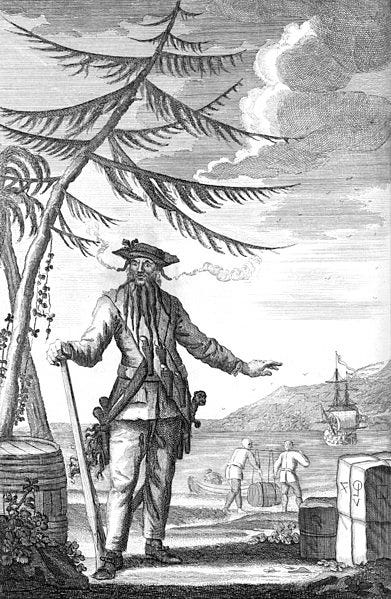
Prior to the Revolutionary War, Charleston was one of the wealthiest colonies and its harbor continued to be an important center of trade. Rice and indigo were valuable exports of the colony, while simultaneously, the African slave trade began to take hold. The majority of the slaves that entered the 13 colonies, came to North America through the Charleston Harbor.5
By 1747, the South Carolina colony produced 135,000 pounds of indigo for export. By 1775, that rose to 1,176,000 pounds.
In 1782, tobacco was being grown in small quantities and in the 1790s “almost 10,000 hogsheads (large barrels) were shipped from Charleston.”6
During the American Revolution, major battles were fought in the harbor, including the Battle of Sullivan’s Island on June 28th, 1776, which was a major Patriot victory over the British. The patriots had built a fort made of palmetto logs, and thanks to the “rubbery” nature of the palmetto, the British cannonballs deflected off the fort and helped them win their victory. This fort was later named Fort Moultrie.
While there were cheers of victory for South Carolinians in 1776, on May 12, 1780, the British returned with a vengeance and laid siege to Charleston. In what may have been the “greatest defeat of the war for the Americans”, 5,000 American soldiers surrendered to the British. South Carolina wouldn’t gain back the harbor until December of 1782.
Following the Revolutionary War, Charleston Harbor continued to prosper. In 1791, President George Washington made his historic visit to Charleston and took a harbor tour, with particular focus on Fort Johnson and Fort Moultrie and the roles those locations played in the recent war.
1783-1808 was the peak of the international slave trade in Charleston when approximately 100,000 slaves (majority were West African) were brought to Gadsden’s Wharf. 7
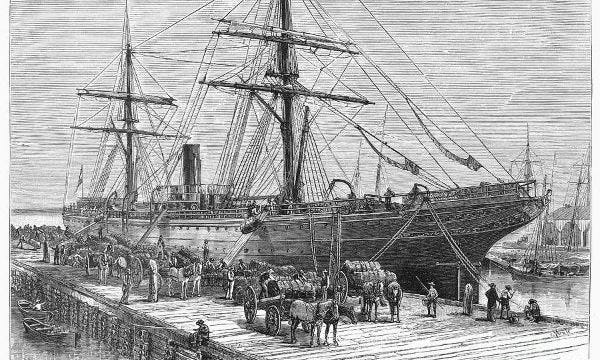
Charleston Harbor soon became the epicenter of the start of the Civil War. Charleston was where South Carolina delegates seceded from the Union in December 1860. At 4:30 am on April 12, 1861, the first shot of the Civil War was fired from Fort Johnson at Fort Sumter. From the American Battlefield Trust: “A 34-hour bombardment ensued which resulted in no deaths, and the surrender of the United States garrison. Confederate forces took Fort Sumter.”
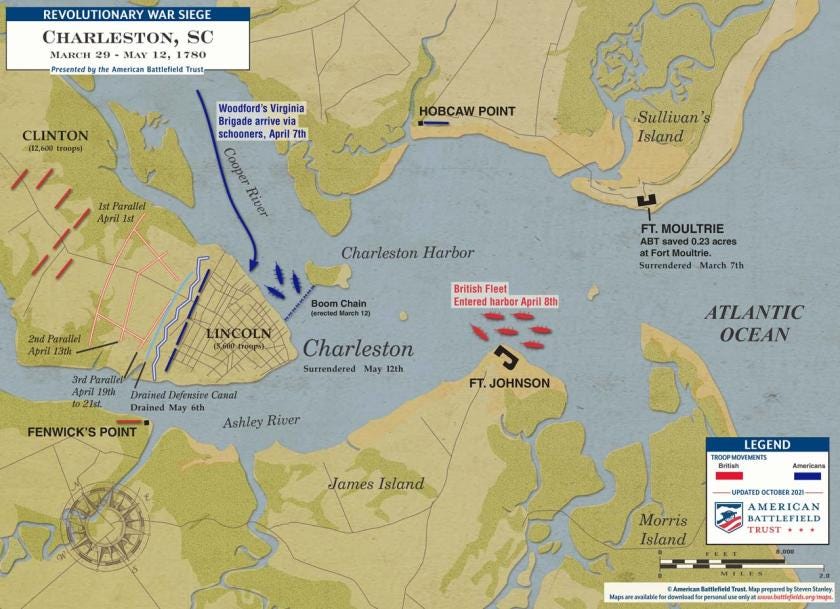
Charleston Harbor continued to be a focal point of the Civil War. On May 28, 1861, Union ships set up a blockage outside of Charleston Harbor. Charleson was seen as “an important strategic port and symbolic prize.”
For the Confederate government, in order to get government and civilian goods in and out of the harbor, private companies owned and operated “blockade-runners” which were “specialized, steam-propelled” boats that could “outrun enemy gunboats and carry 500 to 2,000 bales of cotton.”8
According to the South Carolina Encyclopedia:
“Though the Confederate government operated blockade-runners, the majority of the vessels were owned and run by private companies that made tremendous profits by importing supplies and exporting cotton. The majority of the war’s blockade-running firms were formed at Charleston. Among them were the Palmetto, Chicora, and Charleston Importing and Exporting Companies and the Importing and Exporting Company of South Carolina. The South’s largest and most successful blockade-running firm was operated by George A. Trenholm, who oversaw the Charleston-based John Fraser and Company and its Liverpool office, Fraser, Trenholm and Company, which was operated by Charles K. Prioleau. Trenholm’s firms operated some thirty-five blockade-runners; shipped more than 45,000 bales of cotton, or nearly twenty percent of all cotton to leave the South during the war; and imported tons of civilian and military goods. The firm worked closely with the Confederate government and served as the Confederacy’s bankers in Europe. The firm made an estimated $20 million.”
Even before the Civil War, George Trenholm was indeed a wealthy businessman, financier, and slaveholding planter. He would become the Secretary of the Treasuring during the final year of the Civil War.
Note from Kate: As I researched George Trenholm, I immediately began to think of the character Rhett Butler from Gone With The Wind… could there be a connection to Trenholm? Turns out… there is!
Underwater archaeologist Dr. E. Lee Spence believes that Margaret Mitchell’s famous fictional character Rhett Butler from Gone With The Wind was likely based on George A. Trenholm!9

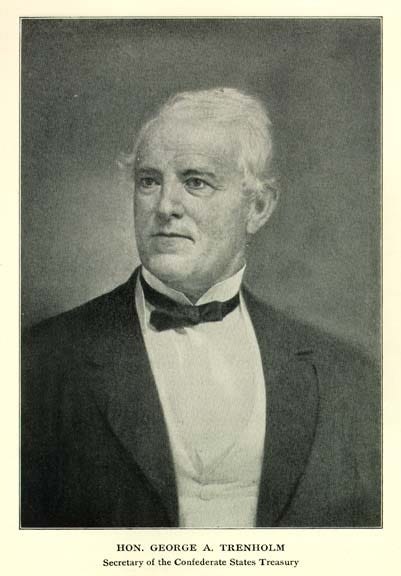
In his article “The Discovery of the “real” Rhett Butler”, Dr. E. Lee Spence writes:
“This article is about George Alfred Trenholm and my discovery and research proving he was the historical figure behind Margaret Mitchell’s fictional Rhett Butler in Gone With The Wind. Why literary scholars and other historians hadn’t seen the link previously still mystifies me, but the editors of Life magazine said I had “overwhelming evidence” and my discovery made international news. The following is a slightly edited and updated version of the first chapter of my book Treasures of the Confederate Coast: the real Rhett Butler & Other Revelations (Narwhal Press, © copyright 1995). All rights reserved.
One day I plan to write and produce a documentary using Trenholm’s beautiful mansions, plantations and shipwrecks to better reveal the facts behind GWTW and the “real Rhett Butler.”
While George Trenholm’s boats evaded the Union blockade, in the summer of 1863, the Union “laid siege” to the Charleston city and harbor. During the siege and into the fall, the Union shot “7 million points of artillery projectiles” at Fort Sumter, which led to “almost total destruction.” Despite the turn of events, it was a Confederate victory. The Confederate troops did not give up Charleston or the harbor.
On the night of February 17th, 1864, The Hunley submarine — the first ever combat submarine — was used by the Confederates in the Charleston harbor and successfully sink the USS Housatonic warship. See SC History Newsletter #45 and SC History Newsletter #113 for more of the fascinating history of the Hunley.

It was only when General William T. Sherman and the Union Army cut through South Carolina through its interior that the Confederate troops in Charleston fell. In April 1865, Union troops re-raised the American Flag at Fort Sumter.
Following the Civil War, Charleston experienced economic depression in the Reconstruction Era. From the S.C. Sea Grant Consortium:
“The Civil War ravaged the South’s rural economy, and for years the region had little to export. Charleston’s network of private wharves rotted in neglect, later to be damaged by fires, major hurricanes, and a catastrophic earthquake. In 1885, a major hurricane smashed the Cooper River waterfront, destroying piers, wharves, offices, and vessels.”
By 1868, a new industry popped up and the first exports of phosphate and fertilizer created a new industry that “boomed” in the last part of the 19th century.
In 1880, cotton make a resurgence as a cash crop for the state and “nearly 1.5 million bales per year were exported.” The cotton boom would continue until the horrific invasion of the Boll Weevil pest from Mexico. In this time, tobacco was reintroduced as well.
During World War II, Charleston’s harbor because a “major naval base and shipyard” during the war. The Charleston Naval Shipyard, located in North Charleston, employed thousands of people and build warships and submarines.10
From 1945-1980, the port was made deeper to accommodate even bigger ships as global trade expanded. 11
On September 22, 1989, the category 4 Hurricane Hugo hit landfall near Charleston, which led to widespread devastation and damage to the state. In the Charleston Harbor itself, the hurricane caused damage to docks, cranes, piers, and shipping facilities and disrupted port operations for weeks.12
On July 16, 2005, South Carolina’s now famous Arthur Ravenel Jr. Bridge was built and connected downtown Charleston to Mount Pleasant. 13

In 2022, Charleston harbor became the deepest harbor on the East Coast at 52 feet, which allows for the largest cargo ships to dock. 14
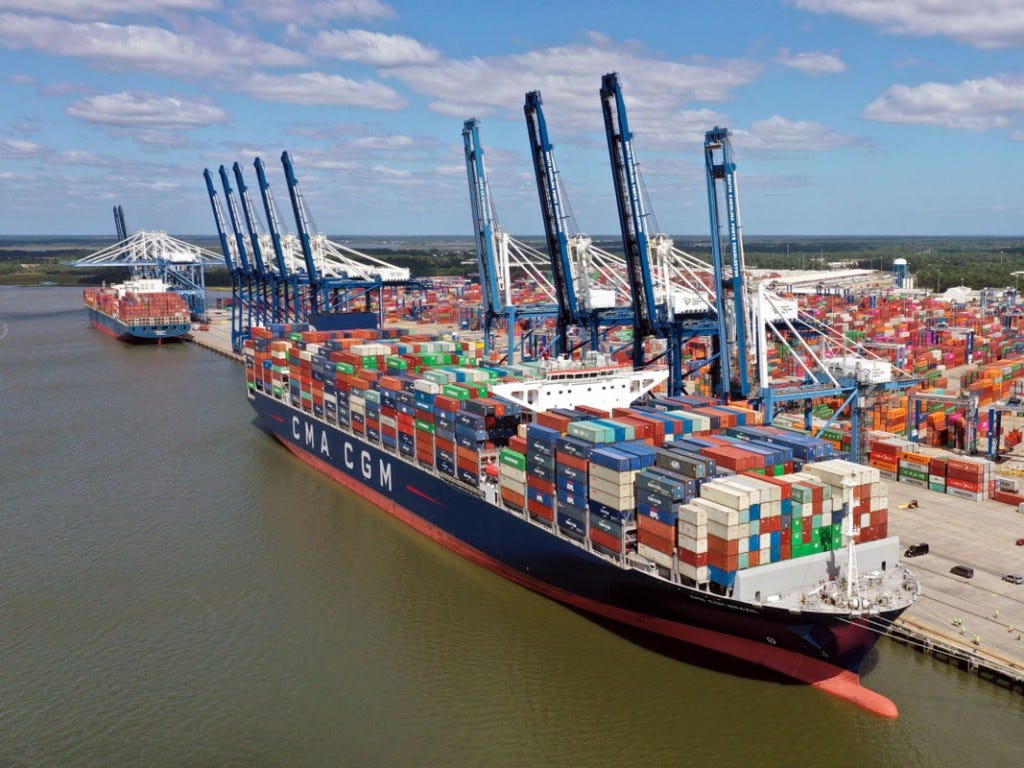
In 1992, a historic announcement was made that BMW would establish their North American plant here in South Carolina. Along with the land needed and the proximity to the airport, South Carolina was ultimately chosen as the location for the BMW plant as well for “the deep-water port of Charleston, its advanced technical college system and the state’s strong work ethic.” See SC History Newsletter #37 for more of the history of BMW in South Carolina.
In a press release from BMW in 2010, they stated:
“Since announcing its arrival in South Carolina in 1992, BMW Manufacturing announced today that it has surpassed the export of over one million vehicles, 85% of which have gone through the Port of Charleston. Currently, over 70% of the vehicles produced in Spartanburg are exported to over 120 worldwide markets.”
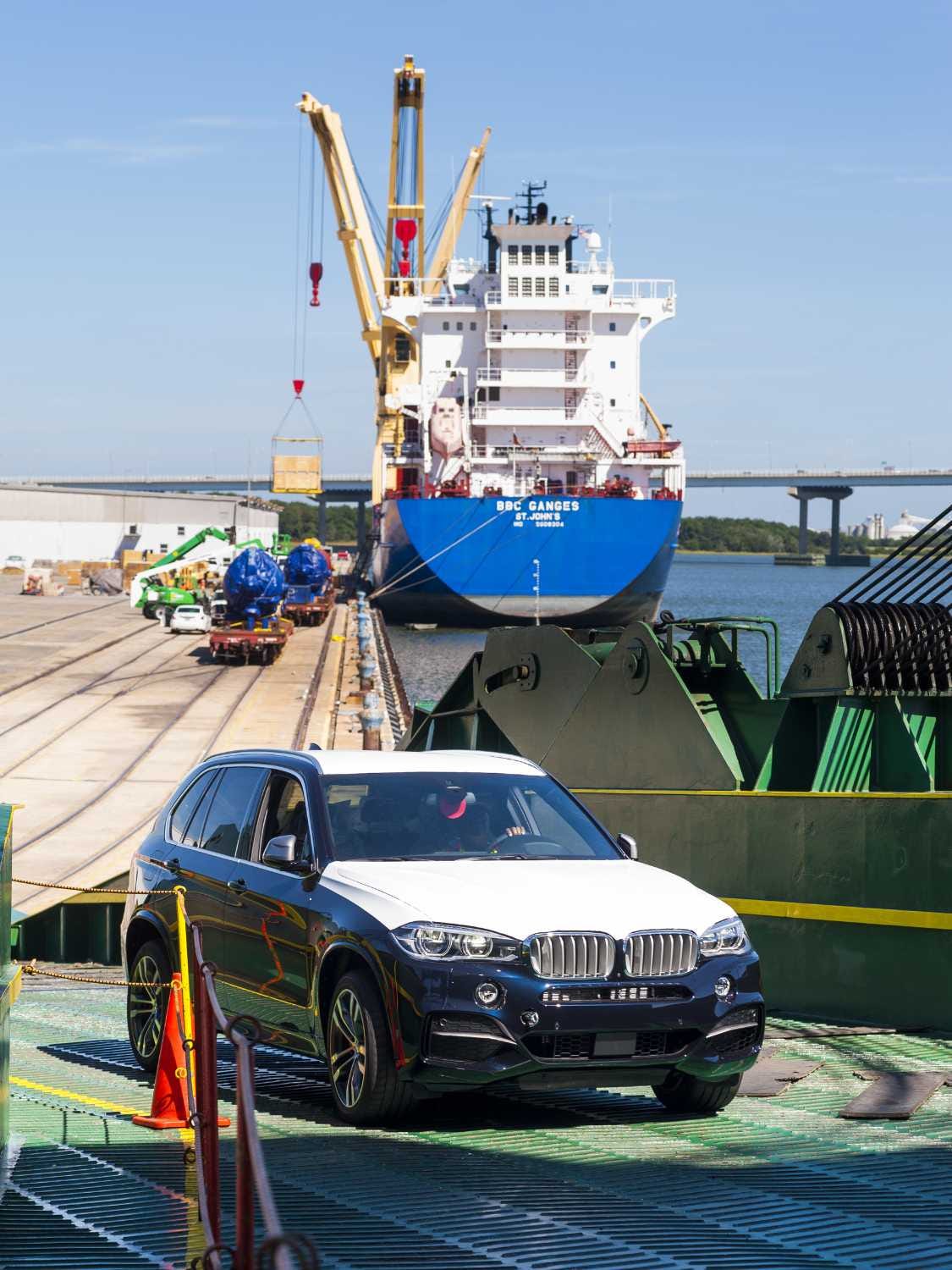
In 2023, SCCommerce.com reported that South Carolina’s top five exported commodities in 2023 were:
Completed passenger vehicles (Note: BMW, Volvo)
Aircraft and parts
Machinery and mechanical appliances (turbojets, turbopropellers, gas turbines, ball and roller bearings, appliances for boilers and pumps)
Plastics
Rubber (tires) (Note: Michelin) 15
Before we end today’s newsletter, let’s also discuss what is below the surface in Charleston Harbor.
The harbor is an “abundant, biodiversity marvel” that is home to: bottlenose dolphins, loggerhead turtles, brown pelicans, great blue herons, egrets, seagulls, terns, kingfishers, king mackerel, sharks, striped bass, sea trout, flounder, rare Atlantic bottlenose whales and manatees, and so much more!16
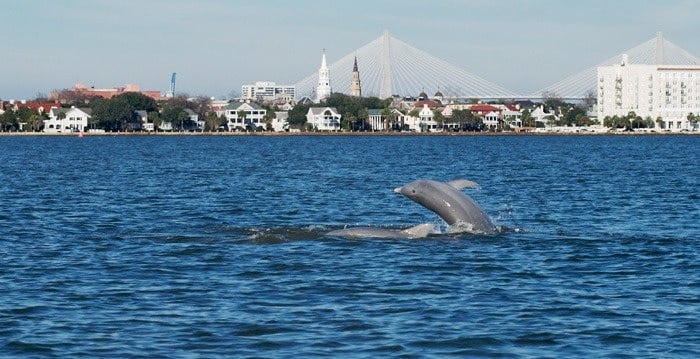
From early colonists, to pirates, to warships, to submarines, to blockade runners, to mega-cargoships, to beautiful bridges, to bottlenose dolphins, and more, the Charleston harbor has certainly seen its fair share of history and stands today as a symbol of the South Carolina’s past, present, and future as an economic force on both the domestic and world stage.
➳ Sources — The History of the Charleston Harbor
“Blockade Running.” South Carolina Encyclopedia, https://www.scencyclopedia.org/sce/entries/blockade-running/. Accessed 24 Jan. 2025.
“Charleston Harbor.” American Battlefield Trust, https://www.battlefields.org/learn/articles/charleston-harbor. Accessed 24 Jan. 2025.
“Charleston Harbor: A Biodiversity Treasure.” Charleston Harbor Tours & Cruises, https://chscruises.com/charleston-harbor-a-biodiversity-treasure/. Accessed 25 Jan. 2025.
“Charleston Has Deepest Harbor on East Coast at 52 Feet.” South Carolina Ports Authority, https://scspa.com/news/charleston-has-deepest-harbor-on-east-coast-at-52-feet. Accessed 25 Jan. 2025.
“Discovery of the Real Rhett Butler.” Shipwrecks.com, https://shipwrecks.com/discovery_of_the_real_rhett_butler/. Accessed 25 Jan. 2025.
“Gadsden’s Wharf.” The Green Book of South Carolina, https://greenbookofsc.com/locations/gadsdens-wharf/. Accessed 24 Jan. 2025.
“Gadsden’s Wharf.” Preservation Society of Charleston, https://www.preservationsociety.org/locations/gadsdens-wharf/#:~:text=Gadsden's%20Wharf%20complex%20was%20the,100%2C000%20West%20Africans%20landed%20here. Accessed 25 Jan. 2025.
“History of Charleston Naval Shipyard – Ms. Noreen Wagers.” Naval Submarine League, https://archive.navalsubleague.org/1997/history-of-charleston-naval-shipyard-ms-noreen-wagers. Accessed 24 Jan. 2025.
“HL Hunley.” American Battlefield Trust, https://www.battlefields.org/learn/articles/hl-hunley. Accessed 25 Jan. 2025.
“Hurricane Hugo.” National Weather Service, https://www.weather.gov/ilm/hurricanehugo. Accessed 25 Jan. 2025.
“July 2005: Arthur Ravenel Jr. Bridge Opens to Traffic.” South Carolina Historical Society, https://schistory.org/july-2005-arthur-ravenel-jr-bridge-opens-to-traffic/. Accessed 25 Jan. 2025.
“Port of Charleston’s Big Ship Capabilities Growing with New Terminal, Deeper Harbor.” American Journal of Transportation, https://www.ajot.com/premium/ajot-port-of-charlestons-big-ship-capabilities-growing-with-new-terminal-deeper-harbor. Accessed 24 Jan. 2025.
“Preserving History: Timeline.” South Carolina Ports Authority, https://scspa.com/about-the-port/our-impact/preserving-history/timeline. Accessed 24 Jan. 2025.
“South Carolina Export Sales Total $37.3 Billion in 2023, Defying National Exports Trend.” South Carolina Department of Commerce, https://www.sccommerce.com/news/south-carolina-export-sales-total-373-billion-2023-defying-national-exports-trend. Accessed 25 Jan. 2025.
I always want to improve my work. Answer the poll below to give me your review of today’s newsletter. I also welcome your suggestions for new content! Simply reply to this email with your ideas. Thank you!
If you voted just “OK” on the newsletter today, I want to hear from you: what would you suggest I improve for next time? Please leave a comment below:
“Charleston Harbor.” American Battlefield Trust, https://www.battlefields.org/learn/articles/charleston-harbor. Accessed 24 Jan. 2025.
“Preserving History: Timeline.” South Carolina Ports Authority, https://scspa.com/about-the-port/our-impact/preserving-history/timeline. Accessed 24 Jan. 2025.
“Charleston Harbor.” American Battlefield Trust, https://www.battlefields.org/learn/articles/charleston-harbor. Accessed 24 Jan. 2025.
Ibid.
Ibid.
“Preserving History: Timeline.” South Carolina Ports Authority, https://scspa.com/about-the-port/our-impact/preserving-history/timeline. Accessed 24 Jan. 2025.
“Gadsden’s Wharf.” Preservation Society of Charleston, https://www.preservationsociety.org/locations/gadsdens-wharf/#:~:text=Gadsden's%20Wharf%20complex%20was%20the,100%2C000%20West%20Africans%20landed%20here. Accessed 25 Jan. 2025.
“Blockade Running.” South Carolina Encyclopedia, https://www.scencyclopedia.org/sce/entries/blockade-running/. Accessed 24 Jan. 2025.
“Discovery of the Real Rhett Butler.” Shipwrecks.com, https://shipwrecks.com/discovery_of_the_real_rhett_butler/. Accessed 25 Jan. 2025.
“History of Charleston Naval Shipyard – Ms. Noreen Wagers.” Naval Submarine League, https://archive.navalsubleague.org/1997/history-of-charleston-naval-shipyard-ms-noreen-wagers. Accessed 24 Jan. 2025.
“Preserving History: Timeline.” South Carolina Ports Authority, https://scspa.com/about-the-port/our-impact/preserving-history/timeline. Accessed 24 Jan. 2025.
“Hurricane Hugo.” National Weather Service, https://www.weather.gov/ilm/hurricanehugo. Accessed 25 Jan. 2025.
“July 2005: Arthur Ravenel Jr. Bridge Opens to Traffic.” South Carolina Historical Society, https://schistory.org/july-2005-arthur-ravenel-jr-bridge-opens-to-traffic/. Accessed 25 Jan. 2025.
“Charleston Has Deepest Harbor on East Coast at 52 Feet.” South Carolina Ports Authority, https://scspa.com/news/charleston-has-deepest-harbor-on-east-coast-at-52-feet. Accessed 25 Jan. 2025.
“South Carolina Export Sales Total $37.3 Billion in 2023, Defying National Exports Trend.” South Carolina Department of Commerce, https://www.sccommerce.com/news/south-carolina-export-sales-total-373-billion-2023-defying-national-exports-trend. Accessed 25 Jan. 2025.
“Charleston Harbor: A Biodiversity Treasure.” Charleston Harbor Tours & Cruises, https://chscruises.com/charleston-harbor-a-biodiversity-treasure/. Accessed 25 Jan. 2025.

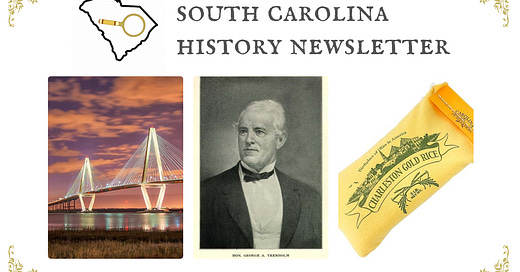








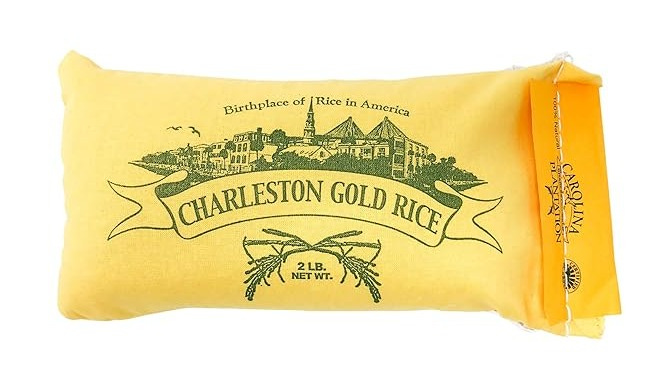





As always, excellent!! I noticed at the beginning you mentioned the harbor was where the Ashley and Cooper meet. Wouldn't this also need to include the Wando or is there something about the system that I don't know like the Wando flows into the Cooper first or something??
This was a fantastic newsletter! It was fascinating to learn about the real-life Rhett Butler. Anytime I hear the term "Blockade-runner," I picture Rhett.
I always love your newsletters and learning more about our great State!